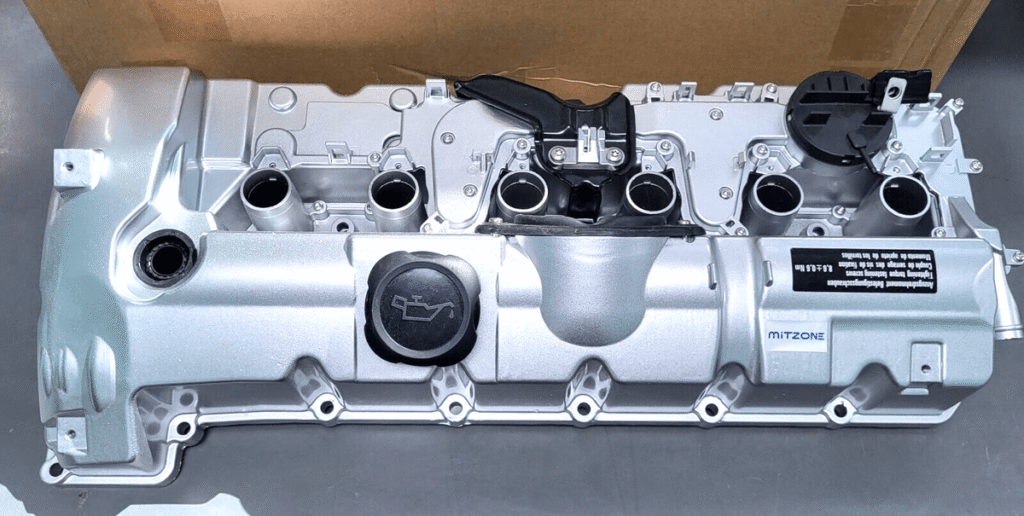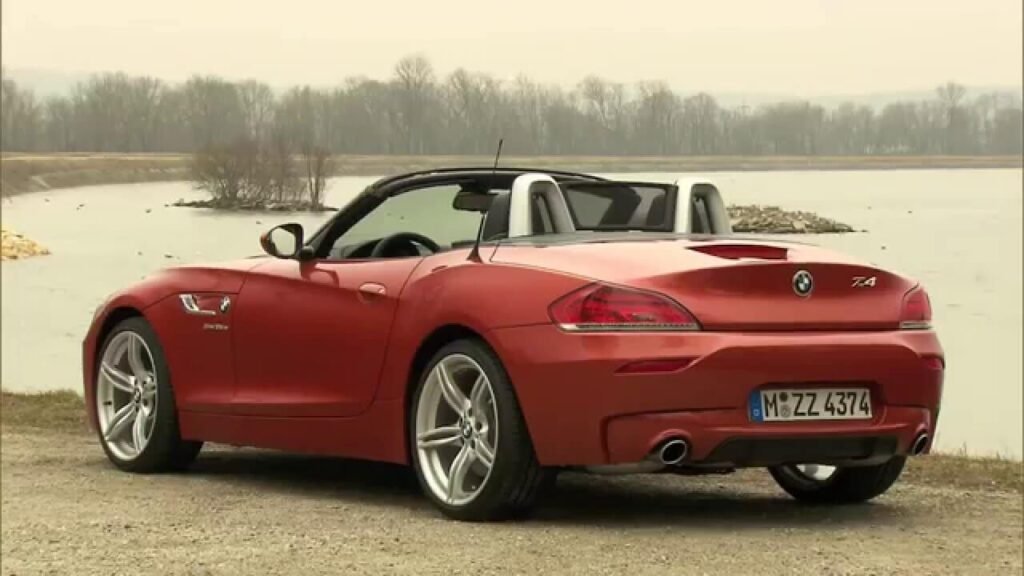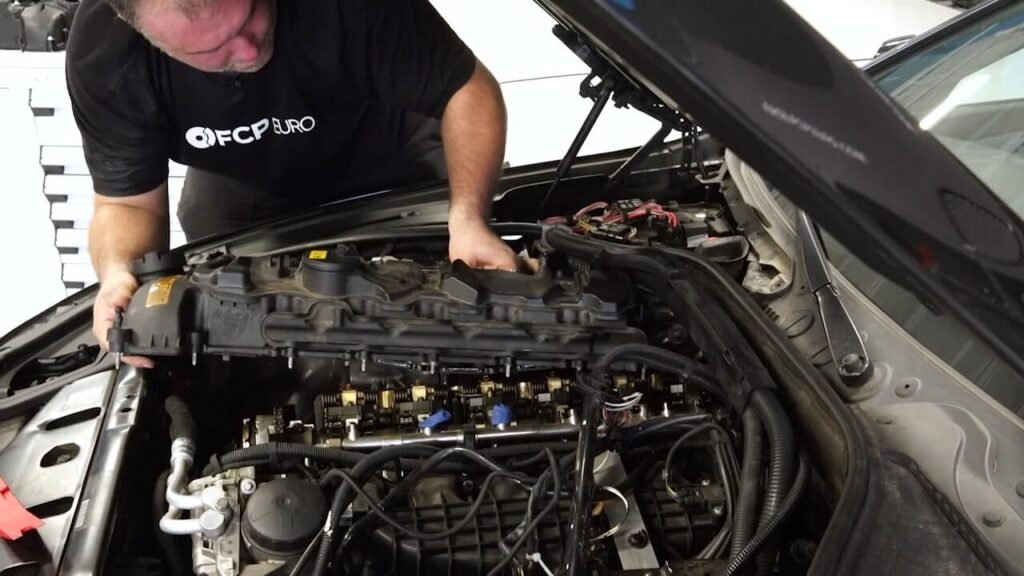Replacing the valve cover gasket is not a cheap task, especially not if you’re an owner of a BMW. Before you make an appointment with the dealership or start dismantling the engine, it’s important to verify that the symptoms match the gasket failure.
Unlike regular cars, BMWs are luxury vehicles with high-end engines that require specialized and expensive parts. If you need a professional to replace the valve cover gasket, be prepared to spend at least $500 – $750. You can save most of the cost by doing the replacement yourself.
What’s a Valve Gasket?
A valve gasket is a critical component of any engine. It is a seal that sits between the engine’s valves and the cylinder head, and its purpose is to keep the oil and fuel in while keeping the dirt and debris out.
Valve gaskets can wear out over time, and when they do, they can cause all sorts of problems with the engine. One common symptom of a bad valve gasket is excessive oil consumption.
If your car is using more oil than usual, it could be an indication that the valve gasket needs to be replaced. Other symptoms include poor performance, loss of power, and engine noise.
If you suspect that your valve gasket may be bad, it’s best to take it to a mechanic for inspection. They will be able to determine whether or not it needs to be replaced and will also be able to recommend the best course of action.
Replacing a valve gasket can be a fairly complex process, so if you’re not mechanically inclined, it’s best to leave it to the professionals.
What’s a Valve Cover Gasket?
A valve cover gasket is a ring-shaped seal that is placed between the engine’s valve cover and cylinder head. Its main purpose is to prevent oil and other fluids from leaking out of the engine.
Over time, these gaskets can become dried out or damaged, causing them to leak. If you notice oil leaking from your engine, it’s likely that you need to replace your valve cover gasket. In this article, we’ll show you how to do just that.
What Does a Valve Cover Gasket Do?
As we mentioned, a valve cover gasket’s main job is to keep oil and other fluids from leaking out of the engine. It does this by creating a tight seal between the valve cover and cylinder head.
The gasket is made of a soft, pliable material that compresses when the two parts are bolted together. This creates a seal that is resistant to leaks.
Over time, however, the gasket can become dried out or damaged. This can happen for a number of reasons, such as age, heat exposure, or excessive engine vibration. When this happens, the gasket is no longer able to create a tight seal.
As a result, oil and other fluids can leak out of the engine, causing serious damage.

How to Tell If You Need a New Valve Cover Gasket
There are a few signs that you may need to replace your valve cover gasket. First, you may notice oil leaking from the engine. This can happen even if the engine is not running. If you see oil pooled under your parked car, it’s a good indication that you have a leak.
Another sign of a problem is smoke coming from under the hood. This usually happens when the engine is running and is caused by burning oil.
You may also notice that your engine is running rough or misfiring. These are both signs that oil is leaking into the combustion chamber, which can cause serious damage to your engine.
If you notice any of these problems, it’s important to have your car inspected by a mechanic as soon as possible. They will be able to tell for sure if you need a new valve cover gasket and can make the necessary repairs.
How to Replace a Valve Cover Gasket
If you need to replace your valve cover gasket, it requires mechanical knowledge. Still, it’s a process that you can do yourself if you carefully follow the guide.
You’ll need a few tools and supplies, including a new gasket, a screwdriver, and an oil catch pan. You may also need some other items, depending on your vehicle. For example, you may need to remove the battery or air intake hose to access the valve cover.
Before you begin, be sure to consult your vehicle’s owner’s manual. It will have specific instructions on how to replace the valve cover gasket on your particular car. Once you’ve gathered everything you need, follow these steps:
- Remove the old gasket: First, you’ll need to remove the old gasket. Start by unscrewing the bolts that hold the valve cover in place. Once the bolts are removed, lift the valve cover off of the engine. Use a putty knife or other flat object to scrape off any old gasket material that is still stuck to the engine or valve cover.
- Clean the surfaces: Next, you’ll need to clean the surfaces of the engine and valve cover. This will help ensure that the new gasket seals properly. Use a rag to wipe away any dirt, grime, or oil from the surfaces. You can also use a degreaser to remove any stubborn buildup.
- Install the new gasket: Once the surfaces are clean, you can install the new gasket. Start by aligning the gasket with the bolt holes in the valve cover. Then, press the gasket into place.
- Replace the valve cover: Finally, replace the valve cover and screw it into place. Be sure to use a torque wrench to tighten the bolts to the proper specification.
- Check for leaks: Once you’ve replaced the valve cover gasket, start the engine and check for leaks. If you see any oil leaking from around the valve cover, you may need to adjust or replace the gasket.
What’s the Valve Cover Gasket Replacement Cost?
The average cost for a valve cover gasket replacement is between $110 and $350. Labor costs are estimated between $50 and $250 while parts are priced at $100. This range does not include taxes and fees and does not factor in your specific vehicle or unique location.
A valve cover gasket is an essential component of your car’s engine, and it keeps oil from leaking out of the cylinder head. If this seal fails, the oil will leak into the combustion chamber and cause engine damage.
How Much Does It Cost for a BMW?
The cost of replacing the valve cover gasket on your BMW can vary depending on the model of the BMW you have. Generally speaking, the cost to replace the valve cover gasket on a BMW is between $500 and $750.
However, if you have a more expensive model of BMW, the cost to replace the valve cover gasket can be as high as $1,000 or more. If you need to have the work done by a professional, expect to pay even more.
Why Is the Cost for a BMW Higher Than for a Regular Car?
The valve cover gasket replacement cost for a BMW is higher than for a regular car because BMWs are luxury vehicles. They require more expensive parts and labor to maintain and repair them.
When it comes to replacing the valve cover gasket, this is a relatively simple and inexpensive repair on most cars. However, BMWs are designed with a complex engine that is difficult to access, which makes the repair more challenging and, therefore, more expensive.
What Causes Valve Cover Gasket Problems on a BMW?
Valve cover gaskets are one of the most common sources of oil leaks on BMWs. The valve cover gasket seals the space between the cylinder head and the valve cover. Over time, the gasket can deteriorate and cause an oil leak.
The valve cover gasket is also a common source of oil leaks because it is located near the top of the engine, where pressure is highest. This high pressure can cause the gasket to fail over time.
Another common reason for valve cover gasket failures is improper installation. If the gasket is not installed correctly, it can leak.
Finally, some BMWs have design flaws that can lead to valve cover gasket problems. For example, some models have an oil return tube that is too close to the exhaust manifold. This can cause the tube to melt and leak oil.
FAQs

What Are the Most Expensive BMW Models?
There are a few different BMW models that can claim the title of being the most expensive. The BMW i8, for example, has a base price of around $140,000.
The BMW 7-Series starts at around $87,000, while the BMW M6 Gran Coupe comes in at just over $120,000. There are also a handful of limited edition and special edition BMWs that command prices well into the six-figure range.
Are BMW Cars High Maintenance?
Owning a BMW comes with certain expectations. You expect your car to be well-made, powerful, and reliable. You also expect it to be expensive to maintain.
BMW cars are indeed high maintenance. They require more frequent and expensive oil changes than most other cars on the road. They also have a lot of complex systems that require special attention and care. As a result, owning a BMW can be quite expensive.
How Much Does It Cost to Maintain a BMW?
The cost of maintaining a BMW varies depending on the model and year of the car. However, in general, you can expect to spend between $1,000 and $1,700 per year on maintenance and repairs. This is in addition to the cost of regular oil changes, which can range from $100 to $150 per year.
What Are the Cheapest BMW Models?
Not all BMWs are created equal. There are a few cheaper models that start in the mid-$30,000 range. These include the BMW 2-Series and the BMW 3-Series. However, these are still relatively expensive cars when compared to the rest of the market.
Are BMW Cars Reliable?
BMWs are generally considered to be reliable cars. However, they do have a few issues that can crop up from time to time.
For example, some models have had problems with their electric power steering systems. BMW has also had issues with recalls in the past. Nonetheless, overall, BMWs are considered to be reliable cars.

Are BMW Cars Safe?
There’s no doubt that BMWs are some of the safest cars on the road. With a wide range of safety features and advanced technology, BMWs offer drivers and passengers alike a high degree of protection. But what exactly makes them so safe?
Some of the most important safety features on BMWs include airbags, seatbelts, and stability control. Airbags provide extra protection in the event of a collision, while seatbelts help keep everyone in the car secure.
Stability control helps keep the car from skidding or sliding out of control, making it easier to stay on the road in treacherous conditions.
In addition to these standard safety features, BMWs also come equipped with some pretty impressive technology. For example, many models now come with blind-spot detection, which can help you avoid accidents when changing lanes.
And BMWs are also available with adaptive cruise control, which can automatically adjust your speed to maintain a safe distance from the car in front of you.
So, yes, BMWs are definitely safe cars. With their combination of safety features and advanced technology, they offer drivers and passengers alike a high degree of protection. If you’re looking for a safe and reliable car, a BMW should definitely be at the top of your list.
Conclusion
If you have a BMW, you can expect to pay more for a valve cover gasket replacement than you would for a regular car. This is because BMWs are luxury vehicles with complex engines that require more expensive parts and labor to maintain and repair them.
If you need to have the work done by a professional, expect to pay even more. You can expect the cost to be between $500 and $750. However, replacing the valve cover gasket is still relatively simple and inexpensive compared to other repairs that your BMW may need.
So if you do find yourself in need of a replacement, don’t hesitate to get it done as soon as possible to avoid any further damage to your engine. You can save most of the cost by doing the replacement yourself.

